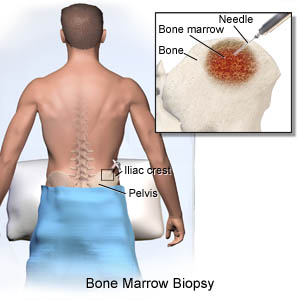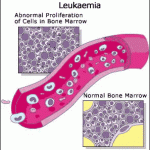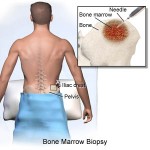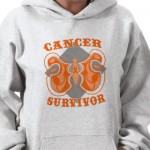In pregnancy
Leukemia is rarely associated with pregnancy, affecting only about 1 in 10,000 pregnant women. How it is handled depends primarily on the type of leukemia. Acute leukemias normally require prompt, aggressive treatment, despite significant risks of pregnancy loss and birth defects, especially if chemotherapy is given during the developmentally sensitive first trimester.
It is possible, although extremely rare, for leukemia to spread from mother to the child. This is called vertical transmission.
Acute myeloid leukemia
Acute myeloid leukemia (AML) is cancer that starts inside bone marrow, the soft tissue inside bones that helps form blood cells. The cancer grows from cells that would normally turn into white blood cells.
Causes, incidence, and risk factors
Acute myeloid leukemia (AML) is one of the most common types of leukemia among adults. This type of cancer is rare under age 40. It generally occurs around age 60. (This article focuses on AML in adults.)
AML is more common in men than women.
Persons with this type of cancer have abnormal cells inside their bone marrow. The cells grow very fast, and replace healthy blood cells. The bone marrow, which helps the body fight infections, eventually stops working correctly. Persons with AML become more prone to infections and have an increased risk for bleeding as the numbers of healthy blood cells decrease.
Most of the time, a doctor cannot tell you what caused AML. However, the following things are thought to lead to some types of leukemia, including AML:
- Certain chemicals (for example, benzene)
- Certain chemotherapy drugs, including etoposide and drugs known as alkylating agents
- Radiation
Problems with your genes may also play a role in the development of AML.
You have an increased risk for AML if you have or had any of the following:
- A weakened immune system (immunosuppression) due to an organ transplant
- Blood disorders, including:
- Polycythemia vera
- Essential thrombocythemia
- Myelodysplasia (refractory anemia)
- Exposure to radiation and chemicals
- Bleeding from the nose
- Bleeding gums
- Bruising
- Bone pain or tenderness
- Fatigue
- Fever
- Heavy menstrual periods
- Pallor
- Shortness of breath (gets worse with exercise)
- Skin rash or lesion
- Swollen gums (rare)
- Weight loss
Symptoms
Signs and tests
The doctor will perform a physical exam. There may be signs of a swollen spleen, liver, or lymph nodes.
A complete blood count (CBC) shows anemia and a low number of platelets. A white blood cell count (WBC) can be high, low, or normal.
Bone marrow aspiration will show if there are any leukemia cells.
If your doctor learns you do have this type of leukemia, further tests will be done to determine the specific type of AML. There are eight subtypes of AML. They range from M0 to M7, based on which blood cells are abnormal.
Treatment
Treatment involves using medicines to kill the cancer cells. This is called chemotherapy. But chemotherapy kills normal cells, too. This may cause side effects such as excessive bleeding and an increased risk for infection. Your doctor may want to keep you away from other people to prevent infection.
Other treatments for AML may include:
- Antibiotics to treat infection
- Bone marrow transplant or stem cell transplant after radiation and chemotherapy
- Red blood cell transfusions to fight anemia
- Transfusions of platelets to control bleeding
Most types of AML are treated the same way. However, a form of AML called acute promyelocytic leukemia (APL) is treated with a medicine called all-trans retinoic acid (ATRA). This medicine helps leukemia cells grow into normal white blood cells.
The drug arsenic trioxide is for use in patients with APL who do not get better with ATRA or chemotherapy.
Support Groups
See:
- Cancer support group
- Leukemia support group
Expectations (prognosis)
When the signs and symptoms of AML go away, you are said to be in remission. Complete remission occurs in most patients.
With treatment, younger patients with AML tend to do better than those who develop the disease at an older age. The 5-year survival rate is much lower in older adults than younger persons. Experts say this is partly due to the fact that the body of a younger person can better tolerate strong chemotherapy medicines.
If the cancer does not come back (relapse) within 5 years of the diagnosis, you are considered permanently cured.
Complications
Complications of AML and cancer treatment include severe infections and life-threatening bleeding. Sometimes, the cancer comes back (relapses) after treatment.
Calling your health care provider
Call for an appointment with your health care provider if you develop symptoms of AML.
Call your health care provider if you have AML and have a fever that will not go away or other signs of infection.
Prevention
If you work around radiation or chemicals linked to leukemia, you should always wear protective gear.



